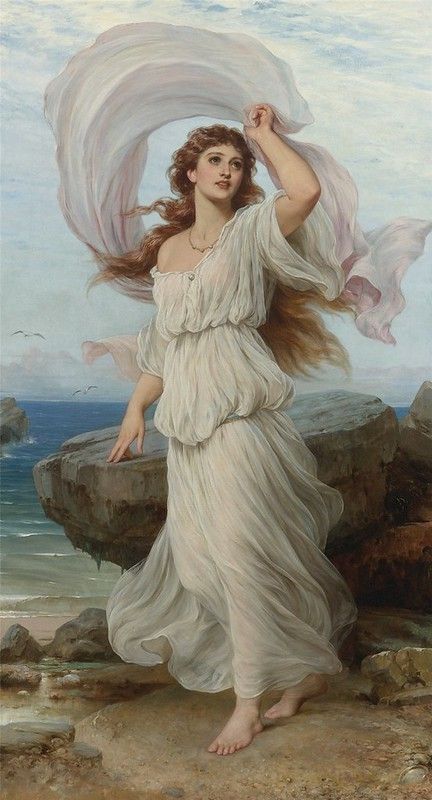Gods and goddesses of love have been worshipped in various cultures throughout history. These deities represent the powerful force of love, which has been a central theme in human existence since the beginning of time. From the Greek goddess Aphrodite to the Hindu god Krishna, the gods and goddesses of love have been an integral part of religious and cultural traditions around the world.
The gods and goddesses of love have also been associated with various symbols and rituals. For example, the ancient Egyptians associated the goddess Isis with the star Sirius and believed that the rising of this star marked the beginning of the Nile flood, which was a symbol of fertility and new life. These deities have played a significant role in shaping human culture and continue to inspire artists, poets, and writers around the world.
Today we’re going over the most famous 19 ancient gods and goddesses of love, as well as some tips for working with or worshipping these deities!
Gods and Goddesses of Love:
19. Aphrodite
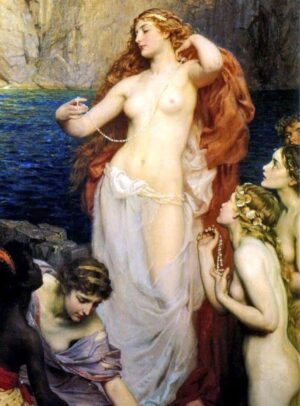
Aphrodite, the goddess of love, beauty, and sexuality, was one of the most popular deities in ancient Greek mythology. She was born from the sea foam after the castration of Uranus by his son Cronus. Aphrodite was married to Hephaestus, the god of fire and blacksmiths, but she had many lovers, including Ares, the god of war, and Adonis, a mortal youth. She was often depicted as a beautiful woman with an irresistible charm and a girdle that had the power to make anyone fall in love with her.
Aphrodite’s irresistible charm was legendary, and artists often depicted her as a stunning woman who exuded allure and grace. One of her most iconic attributes was her magical girdle, which possessed the power to compel anyone who laid eyes on her to fall hopelessly in love. This girdle became a symbol of her dominion over love and desire, further cementing her status as the ultimate goddess of love.
Learn more about working with Aphrodite here.
18. Branwen
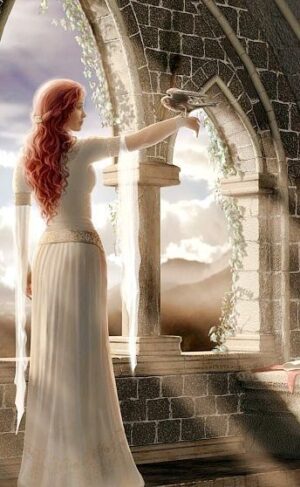
Branwen is a Welsh goddess of love and beauty. She is associated with the sun and is often depicted as a radiant woman with golden hair. Branwen is said to have the power to inspire love and passion in those who gaze upon her.
According to legend, Branwen was the sister of the Welsh king Bran the Blessed. She fell in love with a prince from Ireland and married him, but the marriage ended in tragedy when her brother went to war with her husband. Branwen died of a broken heart, but her beauty and grace live on in the tales and songs of Wales.
Overall, the Celtic gods and goddesses of love are a fascinating and diverse group of deities who embody the power and passion of human love. Whether you are seeking healing, joy, or inspiration, these ancient gods and goddesses can offer guidance and support on your journey.
17. Pothos

Pothos, the god of longing, yearning, and desire, occupied a unique and poignant place in Greek mythology. As one of the Erotes, a group of winged love deities, Pothos embodied the intense emotional aspect of love—the longing and yearning that often accompany it. His portrayal as a youthful figure holding a flower or a lyre served as a visual representation of these deep emotional states.
Pothos was closely associated with the powerful feelings of yearning for a loved one. His presence in ancient Greek culture offered solace and understanding to those who found themselves separated from their beloved, whether by distance, circumstance, or fate. Lovers who pined for the embrace of their partners often invoked Pothos, seeking his divine assistance in easing their pain and reuniting with the object of their affection.
16. Inari Okami
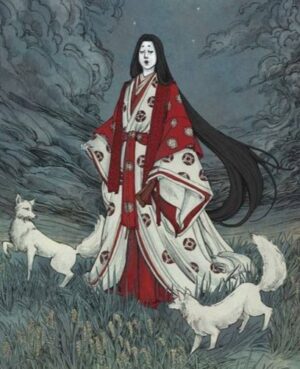
Inari Okami is a Japanese god of fertility, agriculture, and foxes. He is also associated with love and prosperity. Inari Okami is often depicted as a fox or a human with fox-like features, and is sometimes shown holding a sheaf of rice or a fox mask.
Inari Okami is worshipped by farmers, who seek his blessings for a good harvest, as well as by merchants, who seek his blessings for prosperity in their business. Inari Okami is also associated with love, and is sometimes called upon by those seeking a partner or wishing to improve their romantic relationships.
15. Venus
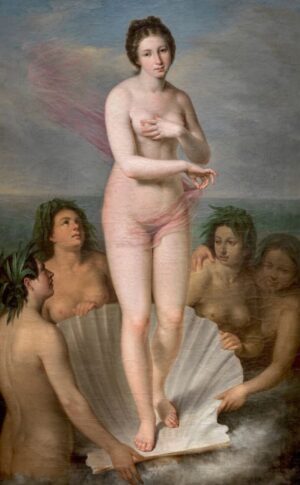
Venus was the Roman goddess of love, beauty, and fertility. She was the daughter of Jupiter and Dione, and her equivalent in Greek mythology was Aphrodite. Venus was often depicted as a beautiful woman, and her symbols included roses, doves, and myrtle. She was also associated with the planet Venus, which was named after her.
Venus was worshipped in many different ways by the Romans. She was often invoked in love spells and was believed to have the power to bring people together in love. She was also associated with fertility and was worshipped by women who wanted to become pregnant.
Venus is often thought to be synonymous with Aphrodite, though she has many of her own qualities, which are included in our post about Aphrodite/Venus if you want to learn more.
14. Eros

Eros, also known as Cupid in Roman mythology, was the god of love and desire, born to Aphrodite and Ares. He’s often depicted as a winged boy with a bow and arrows. Eros would use his arrows to make people fall in love with the first person they saw. He was also linked to fertility and procreation, symbolizing the connection between love and the continuation of life. Eros remains an enduring symbol of love’s unpredictable and powerful nature, recognized across cultures and time.
13. Kamadeva

Kamadeva is the Hindu God of Love and Desire. He is depicted as a handsome young man wielding a bow made of sugarcane and arrows made of flowers. Kamadeva is also known as Manmatha, which means “he who churns the heart”. He is believed to be responsible for arousing romantic love and desire in people’s hearts.
Kamadeva is often depicted with his wife, Rati, who is the Goddess of Love. Together, they are believed to bring happiness and joy to people’s lives. Kamadeva is also associated with the spring season, which is considered to be the season of love and romance.
12. Hathor

Hathor, an integral figure in ancient Egyptian mythology, held the esteemed position of being the goddess of love, beauty, and joy. In artistic representations, Hathor was frequently depicted as a graceful woman adorned with cow horns and a radiant sun disk perched atop her head. These symbolic features tied her to the celestial sphere and the nurturing qualities of cattle, emphasizing her role as a source of abundance, sustenance, and love.
Beyond her association with love and beauty, Hathor’s domain extended to music, dance, and fertility. She was revered as a patroness of the arts, inspiring creativity and celebration among her followers. Hathor’s connection to fertility mirrored the life-sustaining aspect of love, as she was believed to oversee the cycles of birth and renewal in the natural world.
Worshipped in temples dedicated to her honor, Hathor’s devotees sought her blessings in matters of love and happiness. They expressed their devotion through offerings of flowers, food, and jewelry, believing that their tokens of appreciation would secure her favor and bring love and joy into their lives. Hathor’s enduring presence in ancient Egyptian culture underscores the profound human desire for love and happiness and the belief that deities like her could bestow these cherished gifts upon their faithful followers.
11. Oshun
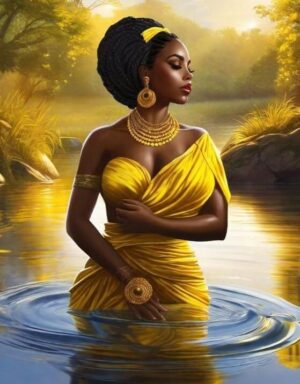
Oshun is a goddess of love, fertility, and beauty in the Yoruba religion of West Africa. She is associated with rivers, especially the Oshun River in Nigeria. Oshun is often depicted as a beautiful, sensuous woman, dressed in yellow and gold.
In Yoruba mythology, Oshun is one of the wives of the god Shango. She is also said to be the mother of the orishas, the deities of the Yoruba religion. Oshun is known for her love of music and dance, and is often depicted playing the bata drums.
10. Cupid
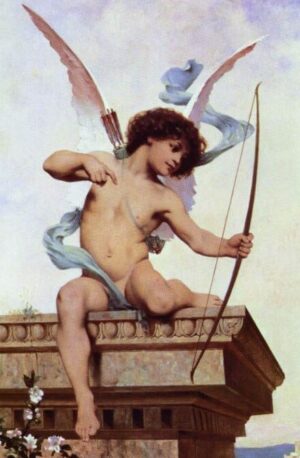
Cupid was the Roman god of love, and his equivalent in Greek mythology was Eros. He was the son of Venus and Mars, and he was often depicted as a winged boy with a bow and arrow. Cupid’s arrows were said to have the power to make people fall in love.
Cupid was a popular figure in Roman mythology, and he was often depicted in art and literature. He was also associated with Valentine’s Day, which is celebrated on February 14th.
9. Amor
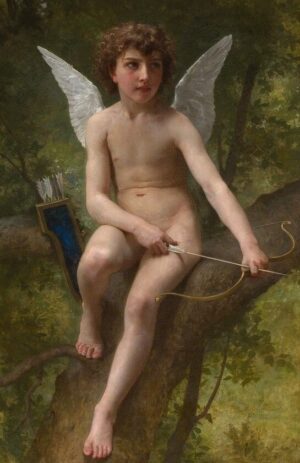
Amor was another name for Cupid in Roman mythology. He was often depicted as a young boy with wings, similar to Cupid. Amor was associated with love and desire, and he was worshipped by the Romans in much the same way as Cupid.
In conclusion, the Roman gods and goddesses of love were an important part of Roman mythology. Venus, Cupid, and Amor were all associated with love and desire, and they were worshipped by the Romans in many different ways. Their stories and symbols continue to be a part of modern culture today.
8. Freyja
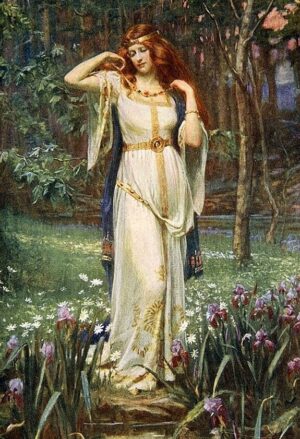
Freyja is the goddess of love, fertility, and war in Norse mythology. She is also associated with beauty, sexuality, and gold. Freyja is often depicted wearing a necklace called Brísingamen and riding a chariot pulled by two cats. She is known for her promiscuity and her ability to choose the souls of half of the warriors who die in battle to join her in her afterlife realm, Fólkvangr.
Freyja is also associated with magic and sorcery. She is said to have taught the god Odin the art of seidr, a type of Norse magic that involves divination and shamanic practices. Freyja is often invoked in love spells and fertility rituals, and she is considered a protector of women and children.
Learn more about working with Freyja here.
7. Aine
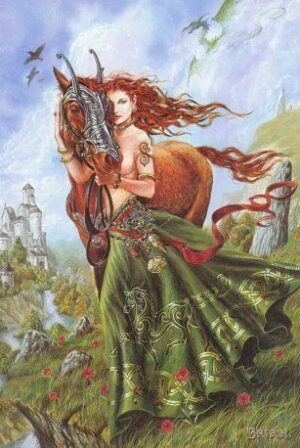
Aine is a Celtic goddess of love, fertility, and sovereignty. She is associated with the summer solstice and is often depicted as a beautiful woman with long, flowing hair. Aine is said to have the power to heal emotional wounds and to bring joy and happiness to those who call upon her.
According to legend, Aine was once a mortal woman who was transformed into a goddess after she fell in love with a king. She is also said to have had many lovers, both mortal and divine, and to have been a patroness of poets and musicians.
6. Frigg

Frigg is the goddess of love, marriage, and destiny in Norse mythology. She is the wife of Odin and the mother of Baldr, the god of light and purity. Frigg is often depicted as a wise and powerful goddess who can see the future and change people’s fates.
Frigg is associated with the home and family, and she is often invoked in marriage ceremonies and childbirth rituals. She is also known for her weaving skills and her ability to spin the clouds in the sky. Frigg is considered a protector of women and children, and she is often depicted wearing a crown of flowers or a veil.
In Norse mythology, both Freyja and Frigg are powerful goddesses of love with their unique roles and associations. While Freyja is often associated with sexuality and war, Frigg is associated with marriage and destiny. Both goddesses are revered for their wisdom, beauty, and power, and they continue to be celebrated in modern times as symbols of love and fertility.
5. Bastet
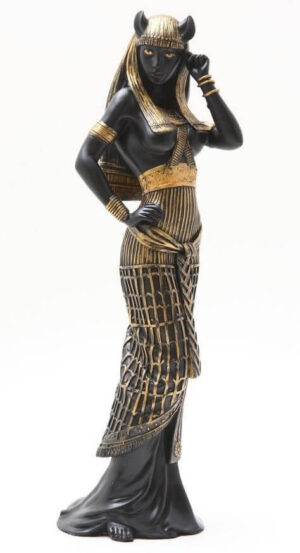
Bastet was the goddess of love, fertility, and cats in Ancient Egypt. She was often depicted as a woman with the head of a cat or as a full cat. Bastet was also associated with protection, and she was believed to have the power to protect people from harm. She was often worshipped in temples, and her followers would offer her gifts of cat figurines, jewelry, and food.
In Egyptian mythology, love was often associated with fertility and procreation. The gods and goddesses of love were believed to have the power to bring happiness and joy to people’s lives, and they were often worshipped in temples. Hathor and Bastet were two of the most popular gods and goddesses of love in Ancient Egypt.
4. Rati
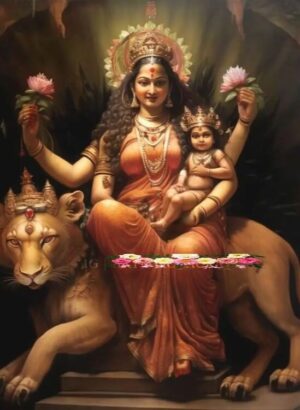
Rati is the Hindu Goddess of Love, Beauty, and Sexual Desire. She is the wife of Kamadeva and is often depicted alongside him. Rati is believed to be the embodiment of feminine beauty and grace. She is also associated with fertility and is considered to be a symbol of abundance and prosperity.
In Hindu mythology, Rati is depicted as a beautiful woman with a lotus in her hand. She is often depicted wearing a crown of flowers and adorned with jewelry. Rati is believed to have the power to arouse desire and passion in people’s hearts.
In conclusion, Kamadeva and Rati are two important Hindu deities associated with love and desire. They are believed to bring happiness and joy to people’s lives and are worshipped by many Hindus around the world.
3. Himeros

Himeros was the god of sexual desire and longing. He was one of the Erotes, a group of winged gods associated with love and desire. Himeros was often depicted as a young man with wings, holding a torch or a lyre. He was a companion of Eros and was sometimes depicted as his twin brother.
2. Benzaiten

Benzaiten is a Japanese goddess of love, music, and water. She is also known as the goddess of knowledge, art, and beauty. Benzaiten is one of the Seven Lucky Gods in Japanese mythology and is often depicted holding a biwa, a traditional Japanese lute. She is also associated with the sea and is sometimes depicted riding on a dragon or a sea serpent.
According to legend, Benzaiten was originally a Hindu goddess named Saraswati, who was brought to Japan by Buddhist monks. In Japan, she became associated with the Shinto goddess of the sea, and her worship spread throughout the country. Benzaiten is often worshipped by artists, musicians, and writers, who seek her blessings for their creative endeavors.
1. Bes
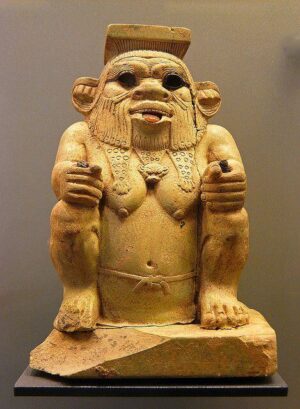
Bes is an ancient Egyptian god of love, fertility, and childbirth. He is often depicted as a dwarf with a bushy beard, wearing a feather headdress and carrying a tambourine. Bes was a popular god among the common people of Egypt, and his image was often used to ward off evil spirits.
In addition to his role as a god of love, Bes was also believed to protect women during childbirth. He was often depicted on household items such as mirrors, combs, and cosmetic containers, as well as on amulets and other protective objects.
Overall, the African gods and goddesses of love represent a rich and diverse tradition of love and fertility deities in African mythology. From the sensuous beauty of Oshun to the protective power of Bes, these deities continue to inspire and fascinate people around the world.
How To Work With A Love Deity:
So you’ve decided you want to work with one of the many gods or goddesses of love. But how to go about it?
Connecting with love deities can be a powerful way to explore the multifaceted aspects of love and its impact on your life. Here’s how working with these deities can help you foster self-love, improve your romantic relationships, and gain a deeper understanding of love itself:
1. Self-Love and Confidence:
Working with love deities provides a unique opportunity to embark on a journey of self-discovery and self-empowerment. Many of these deities embody qualities that extend beyond romantic love, emphasizing self-love and self-acceptance. To foster self-love, consider these practices:
Meditation and Visualization: Begin by creating a sacred space dedicated to your chosen love deity. In this space, meditate on the deity’s qualities and visualize yourself embodying those traits. For example, if you’re working with Hathor, visualize yourself as a vessel of joy and self-compassion.
Daily Affirmations: Incorporate daily affirmations that promote self-love and confidence into your routine. These can be simple statements like “I am worthy of love and happiness” or “I embrace my uniqueness.”
Journaling: Keep a journal to record your thoughts, feelings, and progress on your self-love journey. Reflect on moments when you felt confident and loved, as well as areas where you seek growth.
Act on Self-Care: Prioritize self-care practices that nurture your physical, emotional, and mental well-being. Self-love includes treating yourself with kindness and making choices that promote your happiness.
2. Enhancing Romantic Relationships:
If you’re seeking to enhance your romantic relationships, working with love deities can provide valuable insights and blessings. Here’s how you can use their guidance to strengthen your love life:
Relationship Rituals: Create rituals or ceremonies that involve your chosen deity to bless your relationship. For example, lighting a candle and reciting a love prayer can infuse your partnership with positive energy.
Open Communication: Love deities often emphasize open and honest communication. Practice active listening and empathy in your relationships to foster deeper connections.
Healing Past Wounds: If past relationships or experiences have left emotional wounds, seek the guidance of your love deity to help heal and release these emotional burdens. Letting go of past pain can create space for new, healthier love to flourish.
Attraction and Magnetism: If you’re seeking a new romantic partner, invoke the assistance of your love deity to attract the right person into your life. Be open to opportunities and trust the divine timing of love.
3. Understanding Love’s Nuances:
Working with love deities allows you to explore the intricate facets of love, helping you navigate its complexities with greater empathy and wisdom:
Study Their Stories: Delve into the myths and stories associated with your chosen deity. Each story often reveals different aspects of love, from passionate affairs to enduring love, and offers valuable lessons.
Embrace Compassion: Love deities often exemplify compassion and understanding. Practice kindness and empathy in your interactions with others, fostering harmonious relationships.
Love as a Universal Force: Recognize that love extends beyond romantic partnerships. Embrace love’s role in family, friendships, and even your connection with the world at large. Love deities can help you appreciate the interconnectedness of all forms of love.
Empower Your Choices: As you deepen your understanding of love, use this wisdom to make conscious and loving choices in your relationships. Recognize that love is not only an emotion but also a conscious decision to nurture and cherish those you care about.
Basically, any work with a deity will help you understand more about the things they rule over, so love deities are perfect if you want to understand the principles of love inside and out.
However, you can also invoke or evoke gods and goddesses of love to help you in a love spell. This is a totally different path, but in my experience, deities don’t care much about what you’re doing. They have bigger fish to fry.
We talk more about how to do these types of invocations/evocations on the Patreon. You can also simply talk to the deity and ask them how they’d like to be called for magickal help.
Symbols Of Love In Ancient Cultures
Love symbols have held profound significance in ancient cultures across the world, often intertwined with the worship and devotion of love deities. These symbols represent the enduring and universal nature of love as a central human experience. And interestingly, you’ll often see symbols of love show up in the myths of very different gods and goddesses of love from different cultures.
Here, we delve into love symbols from various ancient cultures, showcasing the diverse ways in which love has been expressed and revered:
1. Hearts (Various Cultures): Perhaps the most recognizable symbol of love worldwide, the heart symbolizes affection, emotion, and love’s deepest sentiments. Its origins can be traced back to ancient cultures, including the ancient Egyptians, who believed the heart was the source of human wisdom and emotion. In Greco-Roman culture, the heart was associated with the goddess Aphrodite (Venus), reinforcing its connection to love.
2. Doves (Greco-Roman and Mesopotamian): Doves are emblematic of love, peace, and fidelity. In Greek and Roman mythology, doves were sacred to Aphrodite (Venus) and her Roman counterpart, Venus. The image of doves often represented divine love and the harmonious union of lovers. In Mesopotamia, doves symbolized the goddess Ishtar, the embodiment of love and fertility.
3. Roses (Greek and Roman): The rose, with its delicate petals and sweet fragrance, became a symbol of love in both Greek and Roman cultures. According to mythology, the rose was created by Aphrodite and her son Eros (Cupid). Its association with love blossomed, making it an enduring symbol of romantic affection and desire.
4. Love Knots (Celtic and Chinese): Love knots, also known as Celtic knots or Chinese love knots, are intricate patterns with no beginning or end. In Celtic culture, they symbolized the eternal nature of love and interconnectedness. In Chinese culture, they represent love and fidelity, often used as decorative motifs in wedding ceremonies.
5. Cupid’s Arrow (Roman): Cupid, the Roman god of love, was often depicted with a bow and arrow. The arrow symbolized his power to pierce the hearts of mortals and immortals alike, causing them to fall in love. This motif continues to be associated with love and attraction.
6. Lotus Flower (Egyptian and Hindu): The lotus flower holds profound symbolism in both Egyptian and Hindu cultures. In ancient Egypt, it represented rebirth and the eternal cycle of life, making it a fitting symbol for love’s enduring nature. In Hinduism, the lotus symbolizes purity, divinity, and the blossoming of love within the heart.
7. Red String of Fate (Chinese): According to Chinese mythology, an invisible red string connects soulmates from birth. This red string of fate is said to be indestructible, symbolizing the inevitability of two people destined to be together, reinforcing the idea that love transcends time and distance.
8. Ankh (Egyptian): The ankh, a cross-like symbol with a loop at the top, was associated with Hathor, the Egyptian goddess of love, beauty, and joy. It represented life, love, and immortality, making it a powerful emblem of the enduring qualities of love.
9. Swans (Various Cultures): Swans have been associated with love in numerous cultures, including Greek, Hindu, and Native American. In Greek mythology, they were sacred to Aphrodite and represented the purity of love. In Hinduism, swans symbolize grace and purity in love.
The gods and goddesses of love have been an important part of many cultures throughout history. They have been worshipped and revered for their ability to bring love, passion, and fertility to their followers. While each culture has their own unique deities of love, there are many similarities between them. Many of these gods and goddesses are associated with sexuality, fertility, and procreation. They are often depicted as being beautiful, passionate, and powerful.
Some of the most well-known gods and goddesses of love include Aphrodite, Eros, Cupid, and Venus. These deities have been depicted in art, literature, and mythology for centuries, and continue to be popular today.
Despite the similarities between these deities, there are also many differences. Some are associated with specific aspects of love, such as romantic love or familial love. Others are associated with specific animals or symbols, such as doves or roses.
Overall, the gods and goddesses of love continue to be an important part of many cultures today. Whether worshipped as divine beings or simply admired for their beauty and power, they remain a fascinating and enduring aspect of human culture.

